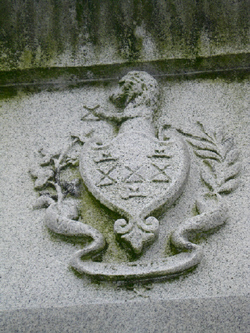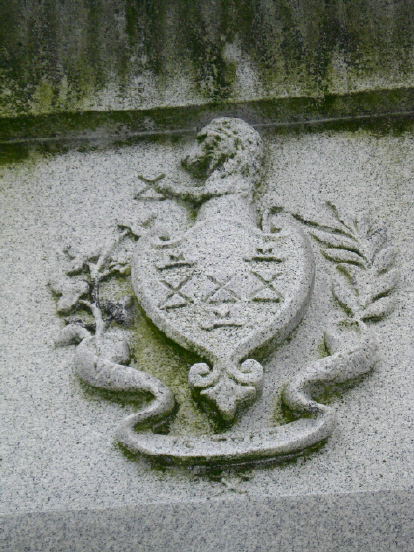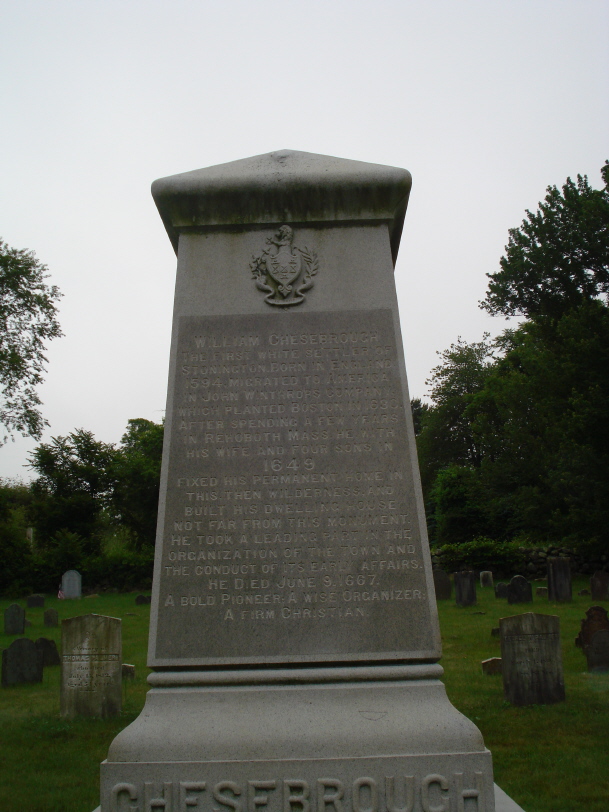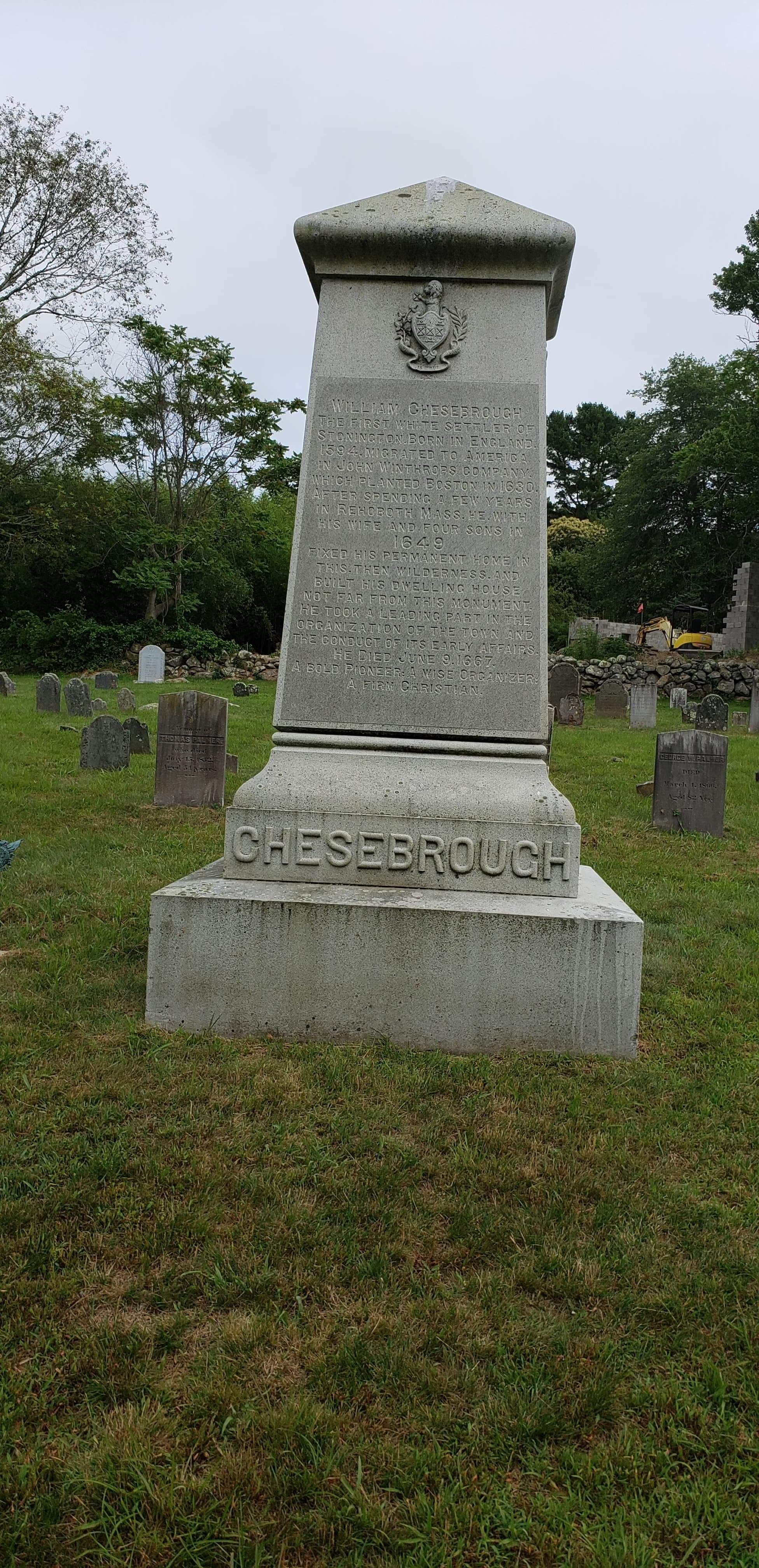Chesebrough was born in Boston, Lincolnshire, England in 1594. On December 6, 1620 (December 15, 1620?), he married Anna Stevenson. He was a gunsmith until he came to Stonington in 1649, when he became a farmer, living on the large grants of land given him by the town of Pequot (now New London).
He came to this country with the John Winthrop Company in 1630 and first settled in Boston, Massachusetts and became a member of the first church. In May 1631, he was admitted a freeman of the Massachusetts Colony.
In 1634, he was elected constable of Boston. He later moved to Braintree, and in 1640 he was elected deputy to the Massachusetts General Court. Soon after, he moved to Rehoboth, Plymouth Colony where he took an active and prominent part in organizing the town of Rehoboth.
The General Court of that colony later ordered him to be arrested for an affray with an Indian, which led him to look further for a new permanent home. John Winthrop, Jr. urged Chesebrough to settle in his new settlement at Pequot, but he decided against it and and finally chose to settle at the head of Wequetequock Cove in the Pawcatuck area instead. It was another friend, Roger Williams, who encouraged and assisted him in moving to Pawcatuck during the summer of 1649 when he moved his family into their new house in Wequetequock, including his wife and four sons, Samuel, Nathaniel, John and Elisha.
Mr. Chesebrough, traded with the Indians and with people of Long Island, which was prohibited by the General Assembly of Connecticut. In January, 1652, the town of Pequot gave him a large tract of land, which was afterwards liberally enlarged until it embraced between two and three thousand acres. Mr. Chesebrough succeeded in drawing around him a number of "acceptable persons" and the settlement of the town was begun. In 1654, however, the planters wanted to separate from Pequot for religious and civil purposes. This measure was resisted by the planters at Pequot. In the meantime, Massachusetts laid claim to the settlement, and the dispute went up to the court of the Commissioners of the United Colonies. In 1658 the court awarded all the territory east of Mystic River to the Massachusetts Colony, under the name of Southertown, until 1662, when it was included in the new charter, and again became a part of the colony of Connecticut. In 1665, the name Southertown was changed to Mystic. In 1666, it was again changed to Stonington.
Mr. Chesebrough held numerous positions of trust not only in the Massachusetts Colony, in the town of Rehoboth, in Plymouth Colony as well. He was elected to several positions between 1653 and 1656.
He held the office of Townsman (Selectman) until Southertown was annexed to Connecticut, and was the first man elected deputy after the reunion. He succeeded in restoring amicable relations with the Court which had been seriously disturbed by the jurisdictional controversy. After his return, he was elected first selectman of the town, and re-elected every year up to the time of his death, on June 9, 1667.
Chesebrough was born in Boston, Lincolnshire, England in 1594. On December 6, 1620 (December 15, 1620?), he married Anna Stevenson. He was a gunsmith until he came to Stonington in 1649, when he became a farmer, living on the large grants of land given him by the town of Pequot (now New London).
He came to this country with the John Winthrop Company in 1630 and first settled in Boston, Massachusetts and became a member of the first church. In May 1631, he was admitted a freeman of the Massachusetts Colony.
In 1634, he was elected constable of Boston. He later moved to Braintree, and in 1640 he was elected deputy to the Massachusetts General Court. Soon after, he moved to Rehoboth, Plymouth Colony where he took an active and prominent part in organizing the town of Rehoboth.
The General Court of that colony later ordered him to be arrested for an affray with an Indian, which led him to look further for a new permanent home. John Winthrop, Jr. urged Chesebrough to settle in his new settlement at Pequot, but he decided against it and and finally chose to settle at the head of Wequetequock Cove in the Pawcatuck area instead. It was another friend, Roger Williams, who encouraged and assisted him in moving to Pawcatuck during the summer of 1649 when he moved his family into their new house in Wequetequock, including his wife and four sons, Samuel, Nathaniel, John and Elisha.
Mr. Chesebrough, traded with the Indians and with people of Long Island, which was prohibited by the General Assembly of Connecticut. In January, 1652, the town of Pequot gave him a large tract of land, which was afterwards liberally enlarged until it embraced between two and three thousand acres. Mr. Chesebrough succeeded in drawing around him a number of "acceptable persons" and the settlement of the town was begun. In 1654, however, the planters wanted to separate from Pequot for religious and civil purposes. This measure was resisted by the planters at Pequot. In the meantime, Massachusetts laid claim to the settlement, and the dispute went up to the court of the Commissioners of the United Colonies. In 1658 the court awarded all the territory east of Mystic River to the Massachusetts Colony, under the name of Southertown, until 1662, when it was included in the new charter, and again became a part of the colony of Connecticut. In 1665, the name Southertown was changed to Mystic. In 1666, it was again changed to Stonington.
Mr. Chesebrough held numerous positions of trust not only in the Massachusetts Colony, in the town of Rehoboth, in Plymouth Colony as well. He was elected to several positions between 1653 and 1656.
He held the office of Townsman (Selectman) until Southertown was annexed to Connecticut, and was the first man elected deputy after the reunion. He succeeded in restoring amicable relations with the Court which had been seriously disturbed by the jurisdictional controversy. After his return, he was elected first selectman of the town, and re-elected every year up to the time of his death, on June 9, 1667.
Inscription
WILLIAM CHESEBROUGH
The first white settler of
Stonington. Born in England,
1594. Migrated to America
in John Winthrop's company,
which planted Boston in 1630.
After spending a few years
in Rehoboth, Mass. he, with
his wife and four sons in
1649
fixed his permanent home in
this then wilderness and
built his dwelling house
not far from this monument.
He took a leading part in the
organization of the town and
the conduct of its early affairs.
He died June 9, 1667.
A bold pioneer: A wise organizer:
A firm Christian
Family Members
-
Marie Chesebrough
1622–1622
-
Martha Chesebrough
1623–1623
-
David Chesebrough
1624–1624
-
Jonathan Chesebrough
1624–1630
-
![]()
Samuel Chesebrough Sr
1627–1673
-
Andronicus Chesebrough
1628–1628
-
Junia Chesebrough
1629–1629
-
Nathaniel Chesebrough
1630–1678
-
John Chesebrough
1632–1650
-
Elisha Chesebrough
1637–1670
-
Joseph Chesebrough
1640 – unknown






